Zapata en el tiempo y la memoria
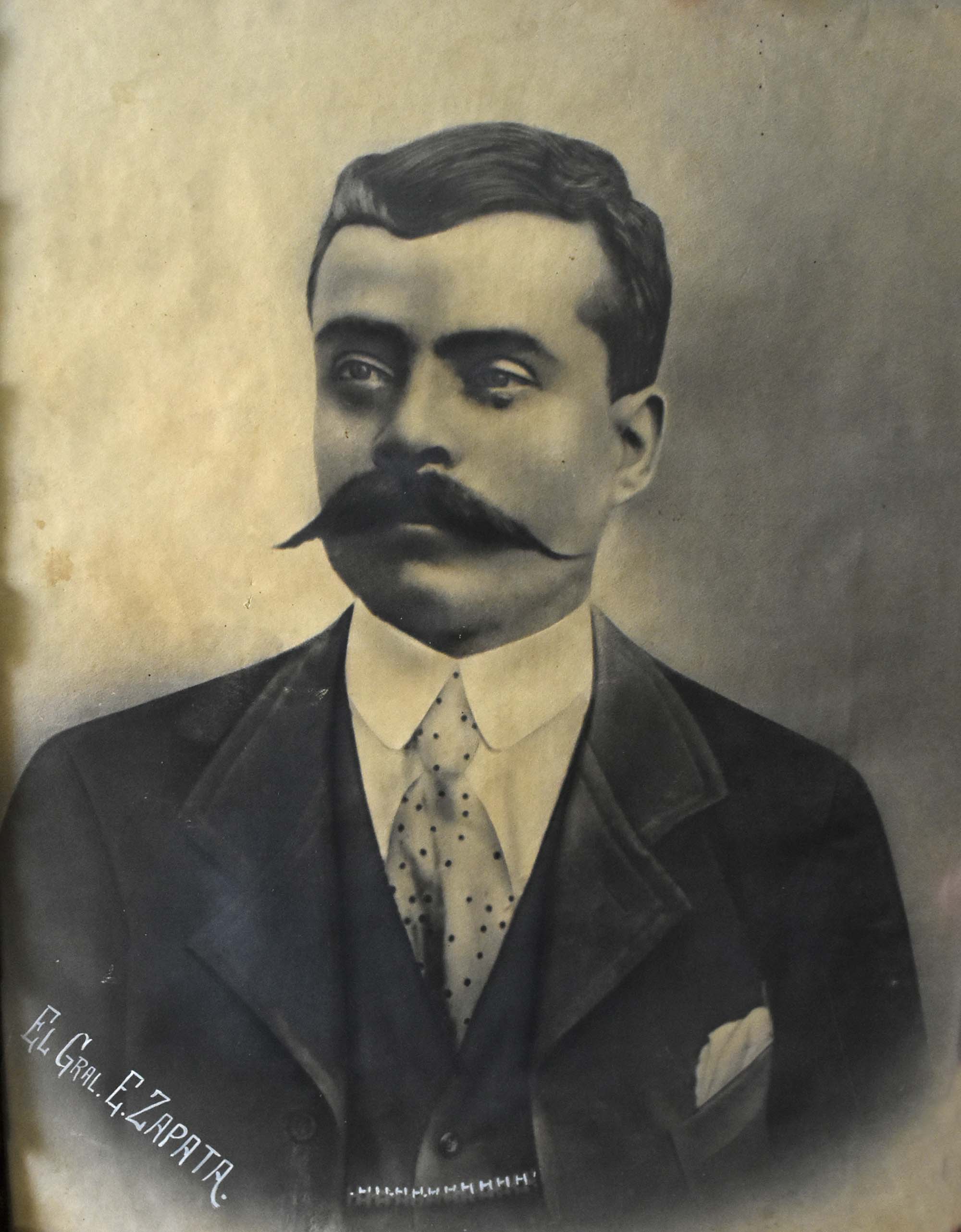
Emiliano Zapata fotografía originalportal
A 141 años del nacimiento de jefe del legendario Ejército Libertador del Sur
Texto y fotos Máximo Cerdio
Cuautla, Morelos, México; 8 de agosto de 2020. Imelda Leticia Zapata Espinoza y su hijo Edgar Rafael Castro Zapata se sientan en unos cómodos sillones al lado de la puerta. A su derecha hay un abreve altar con fotografías familiares; en la pared, detrás de ellos, se levantan dos figuras de pie de tamaño natural, la de Emiliano Zapata Salazar pintado en una manta empuñando un rifle y sobre el muro su hermano Eufemio Zapata Salazar. Son las 10:56 horas.
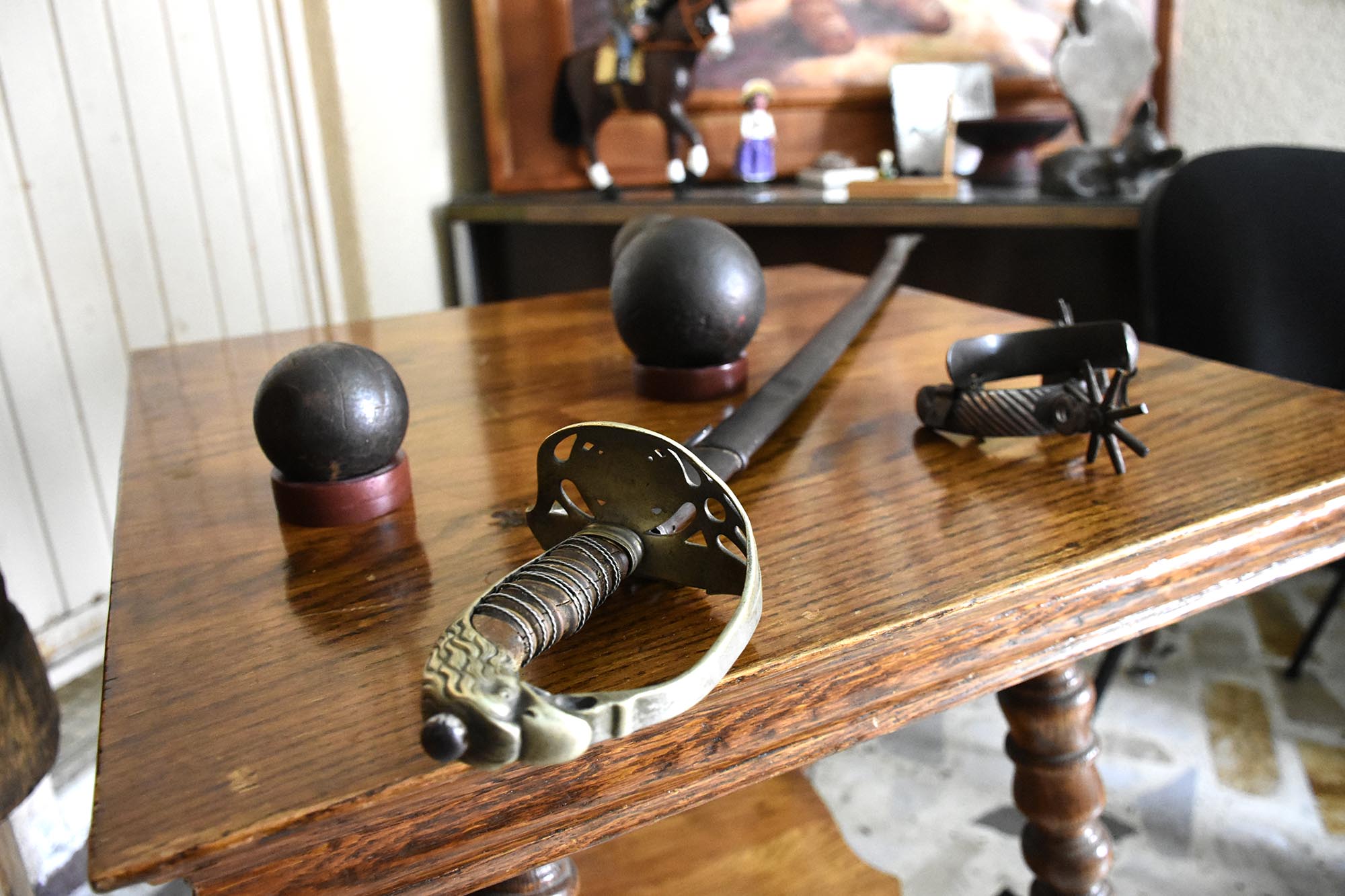
Sable propiedad de Emiliano Zapataportal
En una esquina de este hogar donde vivió Mateo Emiliano Zapata Pérez, hijo del general, hay una mesa pequeña de madera fina; tiene patas gravadas en forma de garras de águila sostenidas por esferas de cristal. Este mueble servía como escritorio para redactar correspondencia; seguramente el secretario se sentaba en una silla ordinaria y le volaban las manos cuando el general Emiliano Zapata Salazar, dando pasos largos frente a él, le dictaba una carta, alguna contestación o párrafos de lo que sería posteriormente el Plan de Ayala. La mesa perteneció a algún hacendado y fue ”expropiada” para servir una noble causa.
Sobre el mueble hay tres balas de cañón de la época, dos espuela con discapacidad usadas por el general y un sable dentro de su funda de metal.
La vaina está oscura, sobre ella han caído muchísimos instantes de tiempo que lo han alejado de las batallas y de las ceremonias importantes en donde era uno de los protagonistas.
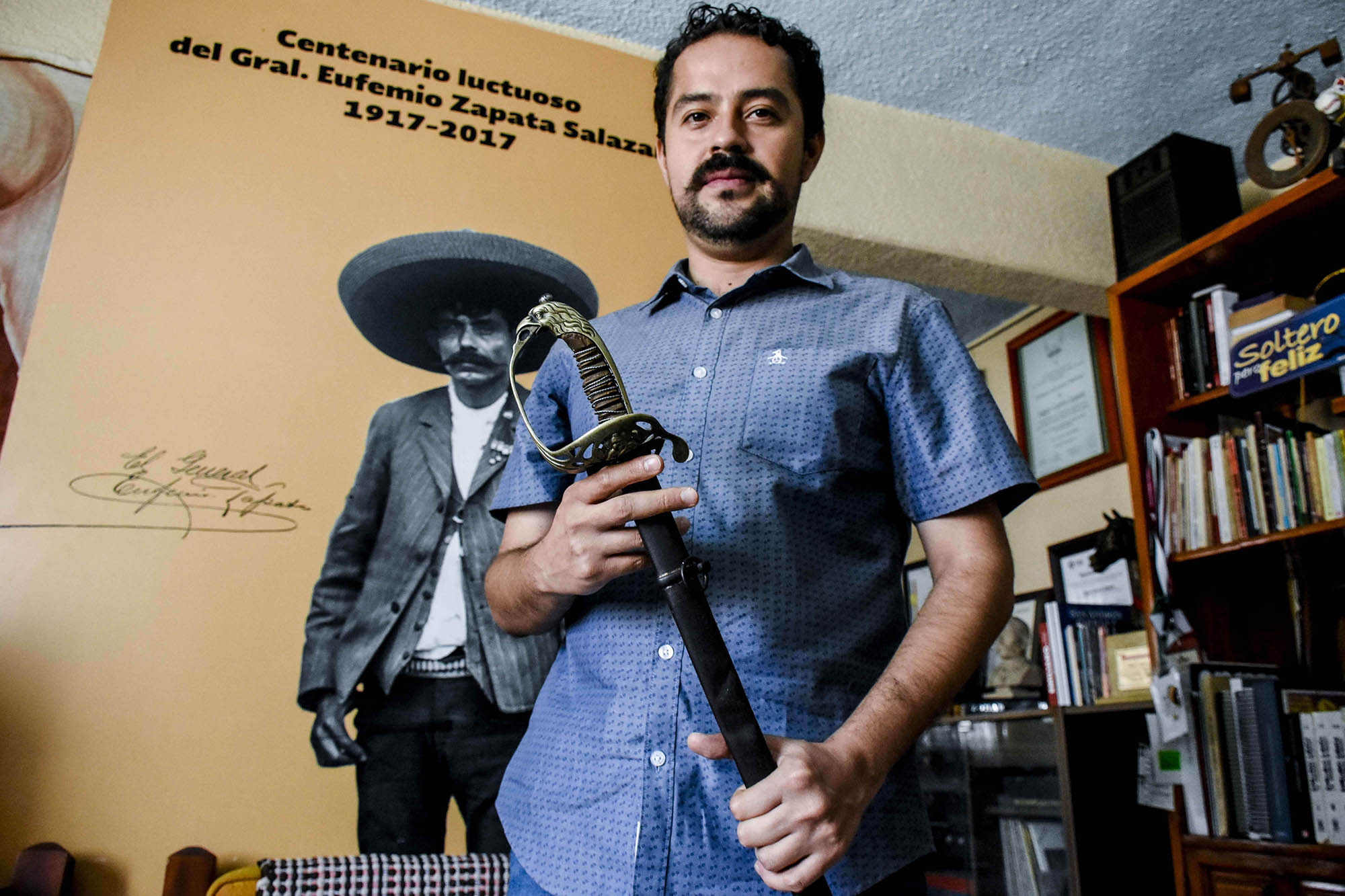
Edgar Castro Zapata2Portal
Edgar Castro Zapata lo toma en sus manos, como seguramente lo ha hecho muchas veces a solas, y lo saca de su funda; el roce del metal con el metal despierta la memoria del arma y Edgar relata que es el sable que usó su bisabuelo en la fotografía más emblemática tomada en 1911 en el Hotel Moctezuma. El general está retratado de cuerpo entero: un metro sesenta y nueve centímetros de valentía, ensombrerado y vestido de charro, cruzado por sus cananas y por una banda. Con la mano derecha levanta a media altura un rifle, con la izquierda empuña el arma punzocortante. De su lado izquierdo hay dos soldados suyos, uno sentado y el otro recargado en un muro de ladrillos. No miran a la lente ni al bulto que dónde se ocultaba el impúdico retratista, sino a lado izquierdo. Lo que estaban observando o a quien están mirando se desconoce, la espada no quiere revelarlo o ya no lo recuerda.
Imelda permanece callada, mira en el pasado los hechos que tantas veces ha leído o escuchado sobre su abuelo.
Edgar va tendiendo puentes entre los hechos que hemos leído en libros o que están ilustrados en las fotografías de sobra conocidas del Caudillo del Sur y otros que no están consignados, pero que ocurrieron y se cuentan de boca en boca entre las familias de quienes los presenciaron.
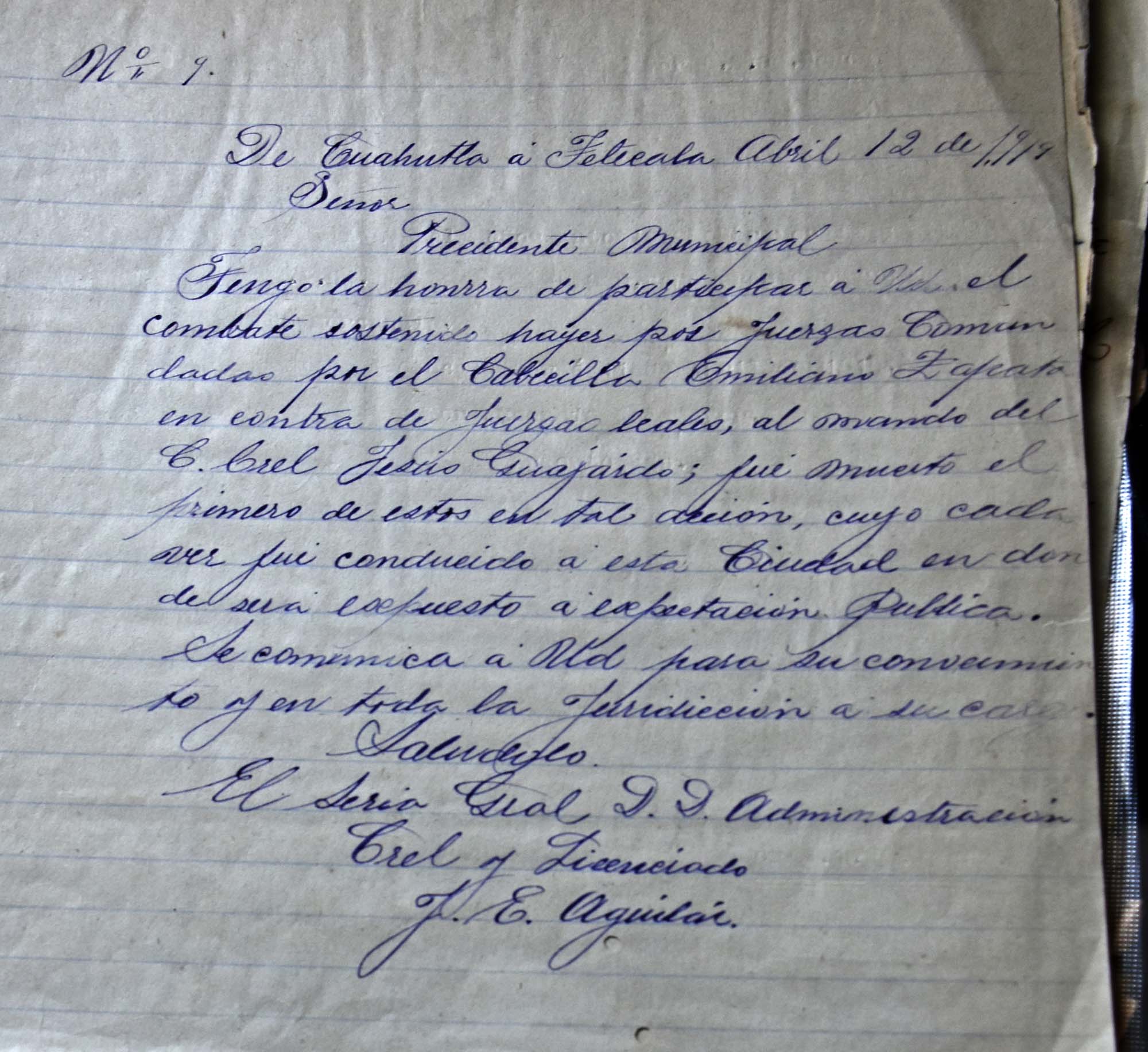
Reporte sobre la muerte de Zapataportal
El parte
La muerte de Emiliano Zapata Salazar el 10 de abril de 1919 fue un hecho que los grupos de poder estuvieron buscando durante mucho tiempo y que culminó con su asesinato en el hacienda de Chinameca.
El coronel Jesús Guajardo y el presidente de México de ese entonces Venustiano Carranza no querían que hubiera duda que habían matado al caudillo del Sur, porque muchas veces lo habían intentado. Además, necesitaban que el pueblo se enterara que el ejército había cobrado la vida del el jefe suriano en batalla, no de la manera en que ocurrió, es decir, en una emboscada y a traición.
Edgar mostró un documento original de puño y letra (ológrafo), con una bellísima caligrafía en tinta china azul, firmado en Cuautla, el 12 de abril de 1919 y dirigido al presidente municipal de Tetecala, el Srio. Gral. de Administración; un tal Gral. y Licenciado J. E. Aguilar, expone:
“Tengo el honor de comunicar a usted el combate sostenido por fuerzas comandadas por el cabecilla Emiliano Zapata en contra de fuerzas leales, al mando del C. Crel. Jesús Guajardo; fue muerto el primero de éstos en tal acción, cuyo cadáver fue conducido a esta ciudad en donde será expuesto a expectación pública. Se comunica a usted para su conocimiento y en toda la jurisdicción a su cargo…”
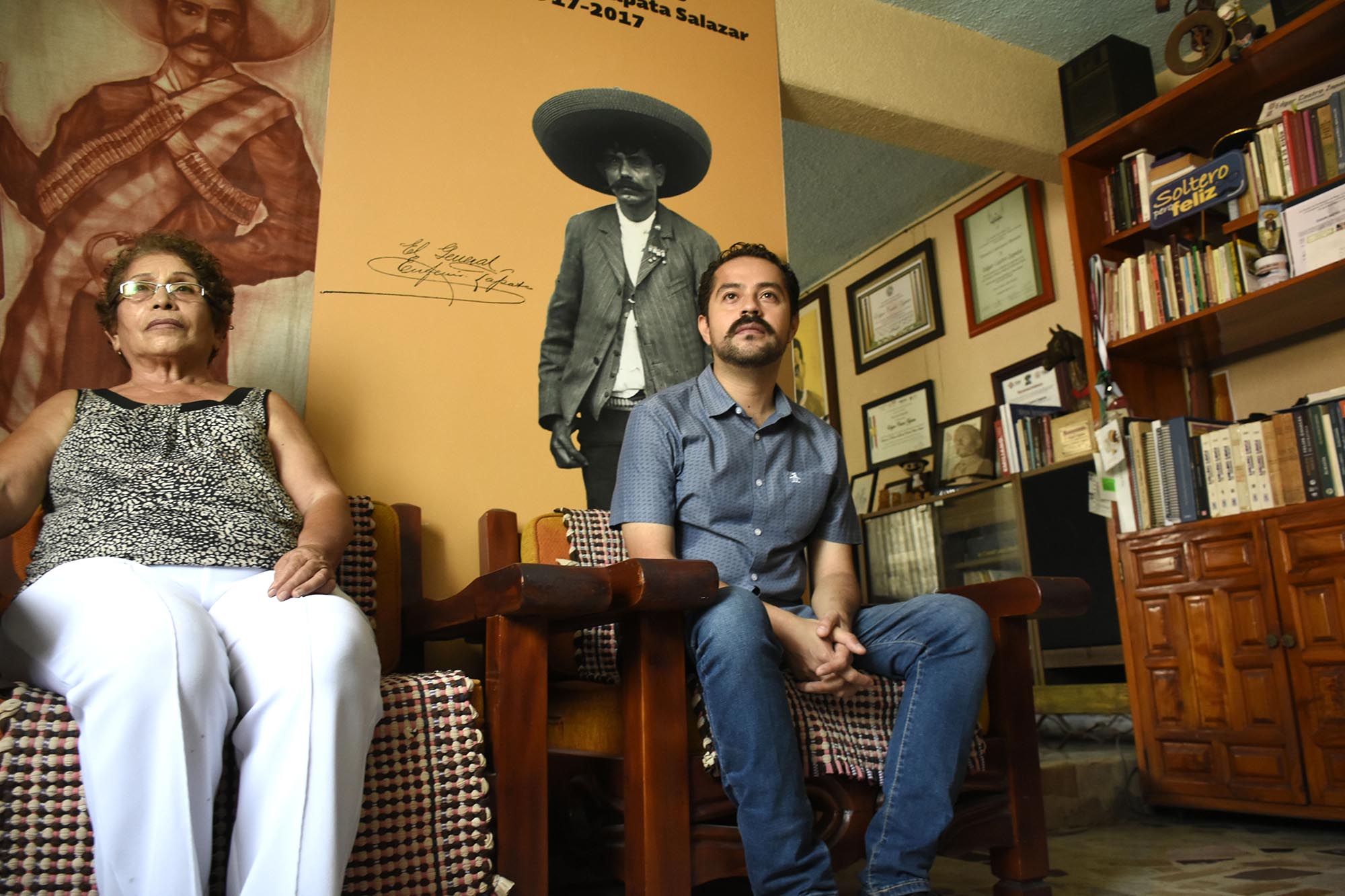
Imelda Leticia Zapata Espinoza y su hijo Edgar Rafael Castro ZapataPortal
La filmación de la muerte de Zapata
Hay fragmentos de películas en blanco y negro en donde se documenta el cadáver del general y su entierro: el gobierno insistía en enseñarlo ante el pueblo como un trofeo y que constara de manera indubitable que el caudillo del sur o el “cabecilla” no estaría dando más problemas.
Hay evidencia de que el asesinato de Emiliano Zapata Salazar fue documentado por medio de una película.
El historiador Fernando del Moral González, escribió un artículo interesantísimo denominado “El cine sobre Emiliano Zapata y la lucha por la tierra”, en él asegura que hay una filmación de la ejecución de Zapata en Chinameca.
De acuerdo con Edgar Castro Zapata, una vez que el general es asesinado en Chinameca, Guajardo lleva el cuerpo, a lomo de bestia, hasta Cuautla. En la información oficial se comunicaba que ya habían matado a Zapata y que “iba” para Cuautla, pero había incertidumbre porque muchas veces, durante el tiempo que duró la rebelión en el sur, se había dicho que habían “capturado” o habían “matado” a Emiliano, pero no era cierto. Entonces, Pablo Gonzáles, el jefe militar, no sabía si era el propio Zapata, vivo, que viajaba hacia Cuautla con Guajardo.
Cuando por la noche llega el cuerpo de Emiliano a Cuautla piden al jefe de escoltas de Zapata, un muchacho de 25 años de nombre Eusebio Jáuregui, que identifique el cuerpo, pero éste se niega a reconocerlo.
Pablo Gonzáles recopila la información. Mandan a Salvador Toscano a que documente el sepelio (la filmación del sepelio de Zapata fue patrocinada por la Azteca Film y fotografiada por Enrique Rosas) y éste filma el cuerpo en el Palacio Municipal, en ese entonces la Comandancia de policía; ahí expusieron los restos del general. Luego se puede ver en la película el cortejo fúnebre rumbo al panteón municipal.
Fernando del Moral González afirmar que consultó varias fuentes que le aseguraron que existe una filmación de la ejecución de Emiliano Zapata en Chinameca, que sirvió a Pablo González para documentar la muerte de caudillo del Sur, y que debió estar en poder de Venustiano Carranza.
Édgar considera que esta película debe darse a conocer a los mexicanos, es una parte muy importante de una verdad que pertenece a los morelenses y a la nación. Y este gobierno encabezado por Andrés Manuel López Obrador podría ser el que mandara a hacer una investigación exhaustiva y, en su momento, difundir este fragmento de la historia de la revolución tan importante para México.
“Uno de los objetivos que tenemos el resguardo del acervo de la memoria zapatista, para preservar y difundir la herencia de los mexicanos; no es exclusivamente de la familia Zapata, sino de los morelenses, de los mexicanos, incuso es patrimonio de la humanidad: Emiliano Zapata es hombre, real, de carne y hueso, que trascendió en el siglo veinte como uno de los máximo líderes del agrarismo”.

Edgar Rafael Castro Zapata 3portal
Eufemio
De acuerdo con Edgar, un mito que se ha desmentido y en el que es necesario insistir es en el de la muerte de Eufemio Zapata Salazar. El 18 de junio de 1917, cayó abatido en una de las calles principales de Cuautla, Eufemio Zapata, a manos de un subordinado suyo, Sidronio Camacho.
Desde los primeros decenios del siglo pasado se difundió, con bastante éxito, la versión de que Eufemio habría sido acribillado por Camacho, en un vulgar pleito de cantina, y a la leyenda se le fueron agregando detalles para oscurecer la historia. Sin embargo, el contexto político en el que ocurre el crimen, y los documentos disponibles permiten presentar otra hipótesis. Sidronio Camacho y Napoleón Caballero, subordinados de Eufemio Zapata, general y jefe de la plaza de Cuautla, fueron cooptados por los generales Cirilo Arenas y Vicente Rojas, poco antes de asesinarlo.
En “La muerte de Eufemio Zapata”, Edgar Castro Zapata traza algunos rasgos de su tío bisabuelo.
“El Flaco”, Eufemio, era quince años mayor que Emiliano, y cumplía para el general las comisiones de más confianza. En combate conquistó el grado de general por su valentía y coraje dentro de la revolución zapatista.
De acuerdo con Simón Pineda Barragán, teniente de caballería, el general Eufemio era un hombre muy enérgico y muy decisivo en, casi en lo más malo que en lo bueno, lo que no fue el general Zapata, porque el general Emiliano era un hombre muy recapacitado, no hacía las cosas con violencia, primero las estudiaba para resolver lo que debía de hacerse, lo que no era don Eufemio.
El 2 de diciembre de 1914, el Ejército Libertador de Sur ocupó la Ciudad de México. Luego entró la División del Norte -ambos en el acuerdo de la Soberana Convención de Aguascalientes- y fue Eufemio el encargado de entregar el Palacio Nacional al nuevo presidente provisional Eulalio Gutiérrez. Es famoso su discurso en el Salón Embajadores, a veces adjudicado erróneamente a Emiliano, en cuya parte principal decía:
“Cuando los hombres del sur nos lanzamos a la revolución para derrocar a los dictadores que por la fuerza se habían posesionado de la silla presidencial, hice yo una solemne promesa a mis muchachos: la de quemar la disputada silla, tan pronto como hiciera mi entrada a la capital.
“Esa silla yo creo que tiene un talismán de mal agüero. Porque he notado que todos los que en ella se han sentado, no sé por qué extraño maleficio, se olvidan de sus promesas y compromisos que hicieron y su único sueño dorado es el de permanecer por el tiempo que mayor les fuera posible sentados en esa silla.
“Cuando mis hombres tomaron la capital de la república -continuó Eufemio Zapata– y vine a México, mi primera visita fue al Palacio, con objeto de cumplir la promesa que hice a mis soldados. Pero me encontré con que se la llevó Carranza con la intención, según cuentan que dijo, de sentirse presidente de la república cada vez que se sienta en ella.
“Nosotros los hombres del sur, nos lanzamos a la revuelta no en pos de conquistas de puestos públicos, ni para habitar esplendentes palacios donde pisar alfombras, ni usar magníficos automóviles, como hicieron otros. Nosotros hemos venido peleando por derrocar las tiranías y conquistar con nuestras armas las libertades a las que tanto hemos aspirado, y que a nuestros hermanos les sea impartida la justicia.
“Ya irá usted a Morelos, señor presidente, y se convencerá de lo triste y desolada que está mi tierra natal, con sus pueblos incendiados, con nuestros hogares destruidos por esa gente que no tuvo corazón. Los de Morelos carecen hasta de pan, y yo mismo y mis hijos no tenemos hogar, pero nunca desfallecimos por la conquista de nuestras libertades tan anheladas. Jamás desmayamos ni aún en los momentos de mayor prueba, cuando cansados, fatigados y sin ningún alimento contentábamos para quitar nuestra hambre, con un puñado de habas tostadas”.
Con el tiempo, Eufemio se fue a radicar a Cuautla, donde tenía su casa y era jefe de plaza. Todos saben que apenas aparecía la figura alta en el dintel de la puerta, ya había un grupo de mujeres, niños y viejos esperándolo, tratando de adivinar su estado de ánimo. Si lo veían sonreír, se precipitaban a saludarlo, y él vaciaba los bolsillos para ofrecerles los centavos que traía. En cambio, si lo veían con el ceño fruncido, manteniendo los labios apretados, daban la vuelta rápidamente y echaban a correr, dispersándose. Y es que tenía un genio de los mil diablos.
Los restos de Eufemio Zapata descansan en el panteón municipal de Anenecuilco, Morelos; hace tres años, la familia de Edgar dispuso develar una placa en el lugar en donde está enterrado, como un homenaje póstumo por las batallas que libró en el legendario Ejército Libertador del Sur.
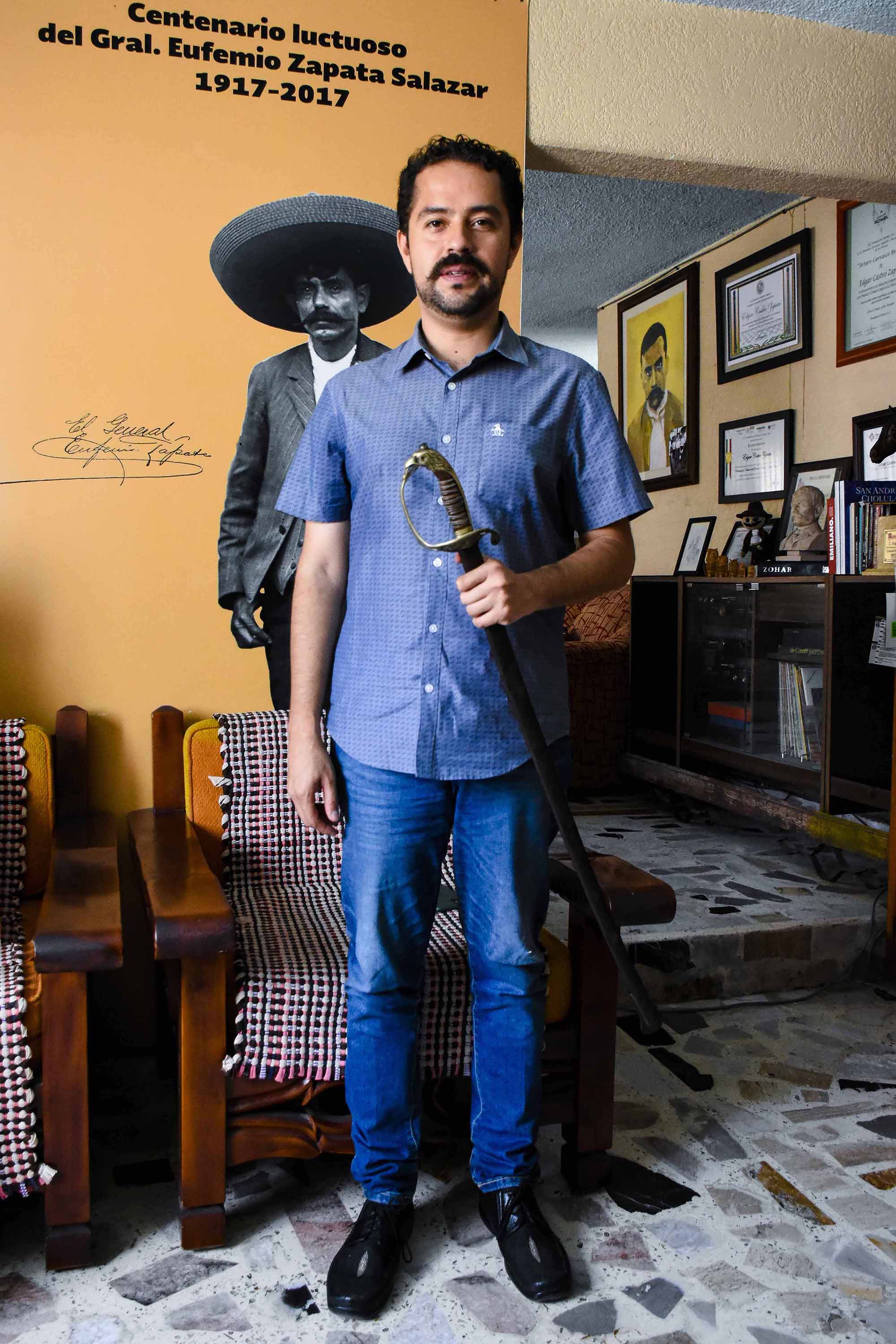
Edgar Castro Zapata1portal
Sobre el tiempo y la memoria
En esta plática que concluidos a las 12:17 horas, brincamos un instante a otro, de un personaje a otro, entramos y salimos por un lapso de más de 140 años y meses, sin un orden cronológico. Ésta, es la única facultad que tenemos los humanos de alterar eso que se llama tiempo y que no perdona vidas, aunque estás sean esplendorosa y se apaguen muy pronto, como la del general Emiliano Zapata Salazar.
Otrosí. Durante toda la entrevista estuvieron presente la señora Imelda Leticia Zapata Espinoza y su hijo Edgar Castro Zapata, el licenciado Pedro Martínez Bello y su hijo, un joven de ojos grandes nombre Daniel Martínez Marquina que supo algo más sobre la vida de un hombre lejano, la periodista Yesenia Daniel Ménez, y el suscrito. Queda para constancia el día domingo veintiséis de julio del año dos mil veinte en la Ciudad de Cuautla, Morelos, México.
Zapata in time and memory
It has been 141 years since the legendary chief of Liberation Army of The South was born
By Máximo Cerdio
Traslation Fernanda Cerdio
Imelda Leticia Zapata Espinoza and her son Edgar Rafael Castro Zapata are standing in comfortable couches next to the door. On their right, there is a brief altar with family pictures; in the wall, next to them, two natural-sized figures are standing right behind, Emiliano Zapata Salazar painted on a blanket wielding a rifle, and on the wall, his brother Eufemio Zapata Salazar. It is 10:56 p.m.
In a corner of this place where Mateo Emiliano Zapata Pérez, son of the general, there is a small table of fine wood; it has engraved legs with the shape of eagle´s claws held by crystal balls. This furniture was used as a desk to write correspondence; surely the secretary used to seat un an ordinary chair and his hands used to fly when The General Emiliano Zapata Salazar, walking around with long steps in front of him, used to dictate a letter, some reply paragraphs of what would later be Ayala´s Plan. The table belonged to a landowner and was “expropriated” to serve a noble cause.
On the top of this furniture, there is three bullets of a cannon of the time, two disabled spurs used by The General and a sable inside its metal case.
The pod is dark, several instants of time have fallen in it that it tore apart battles and important ceremonies when it used to be one of the main characters.
Edgar Castro Zapata holds it, as he surely has before when he is alone, and he takes it out of its case; the metal with metal touching against each other awakens the memory of the soul and Edgar says that it is the sable that his great-grandfather used in the most iconic picture taken in 1911 in Hotel Moctezuma. Zapata is fulll-body portraited: 5.54 feet of braveness, with his hat on, and dressed as a charro, crossed by his cananas and a band. With his right arm he rises at mid height a rifle, and with his left he holds a sharp gun. At his left side there is two of his soldiers, one is seated and the one is leaning against a wall of bricks. Their eyes are not focusing directly on the lens or in the bulge in where the impudent photographer was hiding, but to the left side only. As it what who or what they were looking, it is unknown; the sword will not reveal, or it does not remember.
Imelda stays quiet as she recalls the facts she has read and heard several times about his grandfather.
Edgar builds bridges between the facts we have heard in books or that are shown in the known photographs of the Caudillo del Sur. Some of them were not consigned, but they occurred, and it runs word of mouth between the families that witnessed everything.
He parts
The death of Emiliano Zapata Salazar on April 10th, 1919 was a fact that groups of power searched for a long time and that ended with his murder in Chinameca’s State.
Coronel Jesús Guajardo and Mexico’s president at the time, Venustiano Carranza, did not want there to be any doubt that they have killed the caudillo del Sur, because they have tried to kill him at several times. Also, they needed the people to know that the military took the life of el jefe of the southern region in a battle, not in the way that it really occurred: an ambush and a betrayal.
Edgar showed us an original handwritten document (holographic will), with a beautiful blue-inked Chinese calligraphy, signed in Cuautla on April 12, 1919 written to municipal president of Tetecala, General Secretary of Administration; a so called General and Licenciado J.E. Aguilar, it reads:
“I have the honor to communicate to you the combat sustained by forces commanded by the leader Emiliano Zapata against loyal forces, commanded by C. Crel. Jesús Guajardo; the first of these was killed in such an action, whose corpse was taken to this city where it will be exposed to public expectation. It is communicated to you for your knowledge and in all the jurisdiction under your charge…”
Filming of Zapata’s Death
There are fragments of black and white films where the corpse of the general and his burial are documented: the government insisted on showing it to the people as a trophy and for it to be established beyond doubt that the southern leader or the «ringleader» would not be giving more problems.
There is evidence that the murder of Emiliano Zapata Salazar was documented on film.
The historian Fernando del Moral González wrote a remarkably interesting article called «The cinema about Emiliano Zapata and the struggle for land», in it he assures that there is a film of Zapata’s execution in Chinameca.
According to Edgar Castro Zapata, once the general is assassinated in Chinameca, Guajardo carries the body, on the back of a beast, to Cuautla. In the official information it was reported that they had already killed Zapata and that he was «going» to Cuautla, but there was uncertainty because many times, during the time that the rebellion lasted in the south, it had been said that they had «captured» or had «killed ” Emiliano, but it was not true. Therefore, Pablo Gonzáles, the military chief, did not know if it was Zapata himself, alive, who was traveling to Cuautla with Guajardo.
When Emiliano’s body arrives at Cuautla at night, they ask Zapata’s chief of escorts, a 25-year-old boy named Eusebio Jáuregui, to identify the body, but he refuses to recognize it.
Pablo Gonzáles collects the information. They send Salvador Toscano to document the funeral (the filming of Zapata’s funeral was sponsored by Azteca Film and photographed by Enrique Rosas) and he films the body in the Municipal Palace, at that time the Police Headquarters; there they exposed the remains of the general. It can be seen in the film the funeral procession towards the municipal pantheon.
Fernando del Moral González affirms that he consulted several sources that assured him that there is a filming of the execution of Emiliano Zapata in Chinameca, which served Pablo González to document the death of the leader of the South, and that it must have been in the possession of Venustiano Carranza.
Édgar considers that this film should be made known to Mexicans, it is an especially important part of a truth that belongs to the people of Morelos and to the nation, and this government headed by Andrés Manuel López Obrador could be the one that will order an exhaustive investigation and, in due course, disseminate this fragment of the history of the revolution that is so important for Mexico.
“One of the objectives that we have safeguarding the heritage of Zapatista memory, to preserve and spread the heritage of Mexicans; It is not exclusively of the Zapata family, but of the morelenses, of the Mexicans, even it is a world heritage site: Emiliano Zapata is a man, real, of flesh and blood, who emerged in the twentieth century as one of the greatest leaders of agrarianism »
Eufemio
According to Edgar, a myth that has been denied and in which it is necessary to insist is that of the death of Eufemio Zapata Salazar. On June 18, 1917, Eufemio Zapata was shot dead in one of the main streets of Cuautla at the hands of his subordinate, Sidronio Camacho.
Since the first decades of the last century, the version that Eufemio would have been riddled by Camacho in a vulgar canteen lawsuit, spread with considerable success, and details were added to the legend to obscure the story. However, the political context in which the crime occurs, and the available documents allow us to present another hypothesis. Sidronio Camacho and Napoleón Caballero, subordinates of Eufemio Zapata, general and head of the Plaza de Cuautla, were co-opted by Generals Cirilo Arenas and Vicente Rojas, shortly before assassinating him.
In «The Death of Eufemio Zapata», Edgar Castro Zapata traces some traits of his great-grand uncle.
«El Flaco», Eufemio, was fifteen years older than Emiliano, and he fulfilled for the general the most trusted commissions. In combat he won the rank of general for his bravery and courage within the Zapatista revolution.
According to Simón Pineda Barragán, a cavalry lieutenant, General Eufemio was a very energetic and very decisive man in, almost in the worst thing than in the good, what General Zapata was not, because General Emiliano was a very reconsidered, he did not do things with violence, first he studied them to resolve what should be done, what Don Eufemio was not.
On December 2, 1914, the Liberating Army of the South occupied Mexico City. Then the Northern Division entered -both in the agreement of the Sovereign Convention of Aguascalientes- and it was Eufemio who was in charge of handing over the National Palace to the new provisional president Eulalio Gutiérrez. His speech in the Ambassadors Hall is famous, sometimes erroneously assigned to Emiliano, in whose main part he said:
“When the men of the South launched into the revolution to overthrow the dictators who by force had taken possession of the presidential chair, I made a solemn promise to my boys: to burn the disputed chair, as soon as I made my entrance to the capital.”
“I think that chair has a bad omen talisman. Because I have noticed that all those who have sat in it, I do not for what strange curse, forget their promises and commitments they made and their only golden dream is to stay for as long as possible sitting in that chair .
«When my men took the capital of the republic,» continued Eufemio Zapata, «and I came to Mexico, my first visit was to the Palace, in order to fulfill the promise I made to my soldiers. But I found that Carranza took it with the intention, according to what he said, of feeling like president of the republic every time he sits in it.
“We, the men of the South, launched ourselves into revolt not in pursuit of conquest of public positions, nor to inhabit splendid palaces where we could step on carpets, nor use magnificent automobiles, as others did. We have been fighting to overthrow the tyrannies and conquer with our weapons the freedoms to which we have long aspired, and that justice be imparted to our brothers.
“You will go to Morelos, Mr. President, and you will be convinced of how sad and desolate my homeland is, with its towns on fire, with our homes destroyed by those people who had no heart. The people of Morelos lack even bread, and myself and my children are homeless, but we never gave up for the conquest of our long-awaited freedoms. We never faint even in the moments of greatest trial, when tired, fatigued and without any food we were content to remove our hunger, with a handful of toasted beans.
In time, Eufemio went to settle in Cuautla, where he had his house and was the head of the plaza. Everyone knows that as soon as the tall figure appeared on the door lintel, there was already a group of women, children and old men waiting for him, trying to guess his state of mind. If they saw him smile, they rushed to greet him, and he emptied his pockets to offer them the pennies he brought. Instead, if they saw him with a frown, keeping his lips pressed together, they quickly turned around and ran, dispersing. He had a genius of a thousand devils.
The remains of Eufemio Zapata rest in the municipal pantheon of Anenecuilco, Morelos; Three years ago, Edgar’s family decided to unveil a plaque at the place where he is buried, as a posthumous tribute to the battles he fought in the legendary Liberation Army of the South.
About time and memory
In this talk that ended at 12:17 pm, we jumped from one moment to another, from one character to another, we went in and out for a period of more than 140 years and months, without a chronological order. This is the only faculty that humans have to alter what is called time and that does not spare lives, even if they are splendid and go off very soon, as the one from General Emiliano Zapata Salazar.
During the entire interview, Mrs. Leticia Zapata Espinoza and her son Edgar Israel Castro Zapata, Mr. Pedro Martínez Bello and their son, a young man with big eyes named Daniel Martínez Marquina, who knew something more about the life of a distant man, were present. The Journalist Yesenia Daniel Ménez, and the undersigned (me). It remains for the record on Sunday, July 26, 2020 in the City of Cuautla, Morelos, Mexico.
